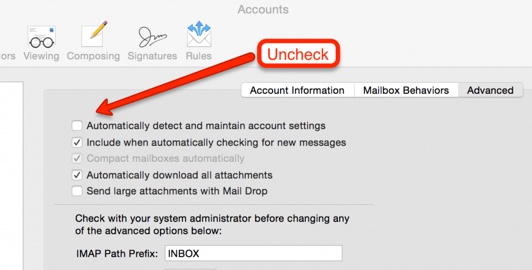Setting an SMTP server for Apple Mail – the default Mac mail client – is necessary to start sending and delivering your emails: but is also extremely easy. Just follow these simple steps:
- Mac Mail Smtp Server Settings
- Mac Mail Incoming Mail Server Greyed Out
- Mac Mail Settings
- Mail For Mac Incoming Mail Server Outlook
- Mail For Mac Incoming Mail Server Download
Sign in to iCloud to access your photos, videos, documents, notes, contacts, and more. Use your Apple ID or create a new account to start using Apple services. If you are using OS X Yosemite v10.10 or later, Mail will automatically attempt to connect to your email provider. See this article. The manual walkthrough and default settings are listed below. Setting Up Your POP or IMAP Email Address with Apple Mail. This tutorial shows you how to set up Apple Mail to work with your email account. To Set Up Your Apple Mail. In the Incoming Mail Server screen, select POP or IMAP from the Account Type list, and complete your information as follows: Description The name of your account.
1. Open the voice “Preferences” in the “Mail” menu.
2. Open the “Accounts” tab and click on “Server settings”.
3. Fill the “Outgoing mail server” voice with your SMTP server name. If you don’t know it, have a look at our list of SMTP parameters or contact your provider.
4. The default “Port” is 25, but there are also other options: to know, check our article about SMTP ports.
5. Finally, choose if you want to authenticate your mailing or not (and in case fill the “User name” and “Password” field). And that’s it.
Remember however that if you plan to set up an email marketing campaign, you should definitely rely on a professional SMTP server – an outgoing server that will guarantee the higest deliverability for all your messages.

Our service turboSMTP offers you 6.000 free relays/month, forever. Try it now!
Mac Mail Smtp Server Settings
Mail User Guide
Use Server Settings preferences in Mail to change options for an account’s incoming and outgoing (SMTP) mail servers.
To change these preferences in the Mail app on your Mac, choose Mail > Preferences, click Accounts, then click Server Settings.
Note: The settings you see vary depending on your account type.
Mac Mail Incoming Mail Server Greyed Out
Incoming mail server settings
Option | Description |
|---|---|
User Name | Your user name on the mail server. |
Password | Your password on the mail server. |
Host Name | The name of the mail server. |
Automatically manage connection settings | Mail automatically manages settings for your email account in Mail, such as port numbers and authentication methods. If you deselect this option, you can specify the following, as directed by your email account provider:
|
Advanced IMAP or Exchange Settings | Enter or change these settings as directed by your email account provider:
|
Mac Mail Settings
Outgoing mail server (SMTP) settings

Mail For Mac Incoming Mail Server Outlook

Mail For Mac Incoming Mail Server Download
Option | Description |
|---|---|
Account | The account of the mail server. To change outgoing server settings, as directed by your email account provider, click the Account pop-up menu, then choose Edit SMTP Server List. |
User Name | Your user name on the mail server. |
Password | Your password on the mail server. |
Host Name | The name of the mail server. |
Automatically manage connection settings | Mail automatically manages settings for your email account in Mail, such as port numbers and authentication methods. If you deselect this option, you can specify the following, as directed by your email account provider:
|
